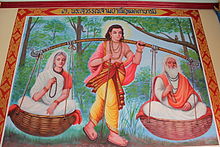|
Jātaka (Pali Canon)
The Jātaka is a Buddhist scripture, part of the Pāli Canon of Theravāda Buddhism. It is included in the Sutta Pitaka's Khuddaka Nikaya.[1] It comprises 547 poems, arranged roughly by an increasing number of verses. The various Indian Buddhist schools had different collections of jātakas, and the definitive Jātaka of the Pali Canon is one of the canonical collections that have existed within various Buddhist traditions.[2] Some of the stories are also found in numerous other languages and media, such the Hindu Panchatantra.[3] HistoryEarly jātakasJātakas were originally transmitted in Prakrit languages and various forms of Sanskrit (from classical to Buddhist Hybrid Sanskrit). They were then translated into central Asian languages (such as Khotanese, Tocharian, Uighur, and Sogdian).[4] Various jātaka stories and source texts were also translated into Chinese and Tibetan for the Tibetan and Chinese Buddhist canons.[5] They were some of the first texts to be translated into Chinese. Kāng Sēnghuì (who worked in Nanking c. 247) was one of the first Chinese translators of the jātakas. Perhaps his most influential translation is the『六度集経』(Pinyin: Liù dù jí jīng; English: Scripture of the Collection of the Six Perfections).[4] Pali traditionThe various Indian Buddhist schools had different collections of jātakas. The largest known collection is the Jātakatthavaṇṇanā of the Theravada school.[2] In Theravada Buddhism, the Jātaka is a definitive textual division of the Pāli Canon, included in the Khuddaka Nikaya of the Sutta Pitaka. The term Jātaka may also refer to a traditional commentaries (Atthakatha) on this book. The tales are dated between 300 BCE and 400 CE.[1] Within the Pali tradition, there are also many non-canonical jātakas of later composition (some dated even to the 19th century) but these are treated as a separate category of literature from the "official" Jātaka stories that have been more or less formally canonized from at least the 5th century — as attested to in ample epigraphic and archaeological evidence, such as extant illustrations in bas relief from ancient temple walls. Apocryphal jātakas of the Pali Buddhist canon, such as those belonging to the Paññāsa Jātaka collection, have been adapted to fit local culture in certain South East Asian countries and have been retold with amendments to the plots to better reflect Buddhist morals.[6][7] According to Kate Crosby, "there is also a collection of jātaka of ten future Buddhas, beginning with Metteyya, which though less well-known today clearly circulated widely in the Theravada world."[8] ParallelsMany of the stories and motifs found in the Jātaka, such as the Rabbit in the Moon of the Sasajātaka (Jataka Tales: no.316),[9] are also found in numerous other languages and media. For example, The Monkey and the Crocodile, The Turtle Who Couldn't Stop Talking and The Crab and the Crane that are listed below also famously featured in the Hindu Panchatantra, the Sanskrit niti-shastra that ubiquitously influenced world literature.[3] Many of the stories and motifs are translations from the Pali but others are instead derived from vernacular oral traditions prior to the Pali compositions.[10] At the Mahathupa in Sri Lanka all 550 Jataka tales were represented inside of the reliquary chamber.[11] Reliquaries often depict the Jataka tales. Famous storiesIn Southeast Asia, the most important and widely known stories are the 10 stories of the Mahānipāta jātaka (Ten Great Birth Stories). These tales are considered to be the ten final lives of the Bodhisatta Gautama and are said to have been the completion of the 10 paramis or perfections.[12] Of these, the Vessantara is the most popular. According to Peter Skilling, part of the reason for its popularity "was the pervasive belief, spread through the Māleyya-sutta and related literature, that by listening to this jātaka one could be assured of meeting the next Buddha, Metteyya."[13] OverviewThe Jātaka in Theravāda's Pali Canon comprises 547 poems, arranged roughly by an increasing number of verses. According to Professor von Hinüber,[14] only the last 50 were intended to be intelligible by themselves, without commentary. The commentary gives stories in prose that it claims provide the context for the verses, and it is these stories that are of interest to folklorists. Alternative versions of some of the stories can be found in another book of the Pali Canon, the Cariyapitaka, and a number of individual stories can be found scattered around other books of the Canon. The following list includes some important jātakas of the Pali Canon:
TranslationsReferences
External links |
Portal di Ensiklopedia Dunia

